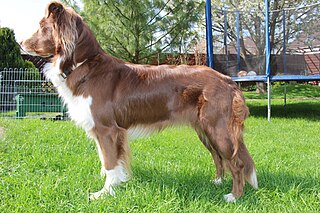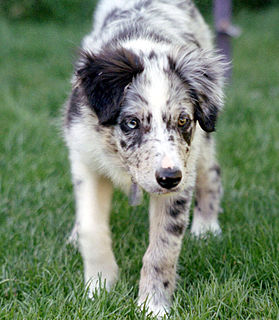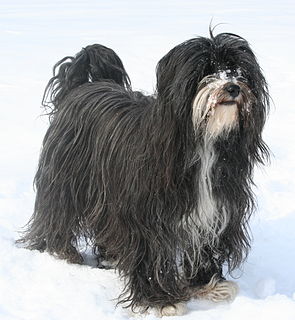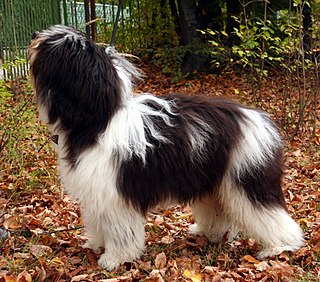
The Australian Kelpie, or simply Kelpie, is an Australian sheepdog capable of mustering and droving with little or no guidance. It is a medium-sized dog and comes in a variety of colours. The Kelpie has been exported throughout the world and is used to muster livestock, primarily sheep, cattle and goats.

The Border Collie is a British breed of herding dog of medium size. Widely considered to be the most intelligent dog breed, they are descended from landrace sheepdogs once found all over the British Isles, but became standardised in the Anglo-Scottish border region. They are now mostly used as working dogs to herd livestock, specifically sheep.

The Catahoula Leopard Dog is an American dog breed named after Catahoula Parish, Louisiana. It became the state dog of Louisiana in 1979. It is recognized by the United Kennel Club under the name Louisiana Catahoula Leopard Dog, while the American Kennel Club Foundation Stock Service calls it Catahoula Leopard Dog. Both registries have assigned the breed a herding group designation, although it has traditionally been used in hunting feral boars.

The Icelandic Sheepdog is a breed of dog of spitz type originating from the dogs brought to Iceland by the Vikings. It is of similar type to the Norwegian Buhund, the Shetland Sheepdog, and the Welsh Corgi. They are commonly used to herd sheep in the Icelandic countryside.

The Shetland Sheepdog, often known as the Sheltie, is a breed of herding dog that originated in the Shetland Islands of Scotland. The original name was Shetland Collie, but this caused controversy amongst Rough Collie breeders of the time, so the breed's name was formally changed. This diligent small dog is clever, vocal, excitable and willing to please. They are incredibly trustworthy to their owners to the point where they are often referred to as "shadows" due to their attachment to family. This breed was formally recognized by The Kennel Club (UK) in 1909.

The Australian Cattle Dog (ACD), or simply Cattle Dog, is a breed of herding dog originally developed in Australia for droving cattle over long distances across rough terrain. This breed is a medium-sized, short-coated dog that occurs in two main colour forms. It has either red or black hair distributed fairly evenly through a white coat, which gives the appearance of a "red" or "blue" dog.

Collies form a distinctive type of herding dogs, including many related landraces and standardized breeds. The type originated in Scotland and Northern England. Collies are medium-sized, fairly lightly-built dogs, with pointed snouts. Many types have a distinctive white color over the shoulders. Collies are very active and agile, and most types of collies have a very strong herding instinct. Collie breeds have spread through many parts of the world, and have diversified into many varieties, sometimes mixed with other dog types. Some collie breeds have remained as working dogs for herding cattle, sheep, and other livestock, while others are kept as pets, show dogs or for dog sports, in which they display great agility, stamina and trainability. While the American Kennel Club has a breed they call "collie", in fact collie dogs are a distinctive type of herding dog inclusive of many related landraces and formal breeds. There are usually major distinctions between show dogs and those bred for herding trials or dog sports: the latter typically display great agility, stamina and trainability, and, more importantly, sagacity.

The Australian Shepherd is a breed of herding dog from the United States. Developed in California in the 19th century, it is claimed the breed descends from a variety of herding breeds including collies imported into California alongside sheep imported from Australia and New Zealand, the breed taking its name from the former. Originally used solely as a herding dog, the Australian Shepherd has become one of the most popular companion dog breeds in North America.

The Rough Collie is a long-coated dog breed of medium to large size that, in its original form, was a type of collie used and bred for herding sheep in Scotland. More recent breeding has focused on the Collie as a show dog, and also companion. The breed specifications call for a distinctive long narrow tapered snout and tipped (semiprick) ears, so some dogs have their ears taped when young. Rough Collies generally come in shades of sable and white, blue merle, tri-colored, and colour-headed white.

The Koolie is an Australian dog breed. The Koolie is a working or herding dog which has existed in Australia since the early 19th century when it was bred from imported British working dogs. Robert Kaleski, in an article on Cattle Dogs in the August 1903 issue of the Agricultural Gazette of New South Wales, describes the "Welsh heeler or merle, erroneously known as the German collie," as a "blue-gray dog about the size and build of a smooth-haired collie, generally with wall eyes." The British background predominated in the dogs that came to be associated with the "German collie" name.

The Miniature Pinscher, also known as the Zwergpinscher, and Min Pin, is a small breed of dog of the pinscher type originating in Germany. The breed's earliest ancestors may have included the German Pinscher mixed with Italian greyhounds and dachshunds.

The McNab Dog, also called the McNab Shepherd or McNab Collie is a herding dog that originated in Hopland, Mendocino County, Northern California. The McNab was bred to withstand the tough conditions found in California such as heat, burrs, foxtails, and rugged terrain. Until recently, the McNab was little known outside California, but in last three decades have seen a gain in popularity and geographic dispersal of the breed.

Merle is a genetic pattern that can be in a dog's coat. Merle comes in different colors and patterns and can affect all coat colors. The merle gene creates mottled patches of color in a solid or piebald coat, blue or odd-colored eyes, and can affect skin pigment as well. There are two general types of colored patches that will appear in a merle coat: liver and black. Some breeds that can be affected by this genetic trait are Carea Leonés, Australian Shepherds and Catahoula Leopard Dogs. This genetic trait should be taken seriously when breeding merles. Health issues are more typical and more severe when two merles are bred together, so it is recommended that a merle be bred with a non-merle dog of any other color.

The Tibetan Terrier is a medium-sized breed of dog that originated in Tibet. Despite its name, it is not a member of the terrier group. The breed was given its English name by European travelers due to its resemblance to known terrier breeds. The Tibetan name for the breed, Tsang Apso, roughly translates to "shaggy or bearded ("apso") dog, from the province of Tsang". Some old travelers' accounts refer to the dog as Dokhi Apso or "outdoor" Apso, indicating a shaggy or bearded working dog which lives outdoors.

The Polish Lowland Sheepdog, is a medium-sized, shaggy-coated, sheep dog breed native to Poland.

The Lancashire Heeler is a small breed of dog developed for use as a drover and herder of cattle. The Lancashire Heeler is listed by the Kennel Club (UK) as an endangered breed.

The Pumi is a medium-small breed of sheep dog from Hungary. They are versatile stock dogs equally adept at gathering, driving and keeping stock under control. They have a long head with semi-erect ears, a whimsical expression, and a tail that forms a circle over the back. The coat is a combination of wavy and curly hair forming curls all over the body.

The Dutch Shepherd is a herding dog of Dutch origin. They were used by shepherds and farmers who needed a versatile dog, with few demands, and a dog that was able to adapt to a harsh and meager existence.

The Welsh Sheepdog is a Welsh breed of herding dog of medium size from Wales.

The Miniature American Shepherd, frequently abbreviated MAS, is a small herding dog breed. The MAS is highly intelligent and biddable. The breed is often trained for dog sports such as herding, agility, obedience, canine freestyle, flyball, and others. The Miniature American Shepherd was recognised by the American Kennel Club (AKC) in 2015 and is the club's 186th breed. In September 2019, the Fédération Cynologique Internationale (FCI) officially accepted the breed.






















